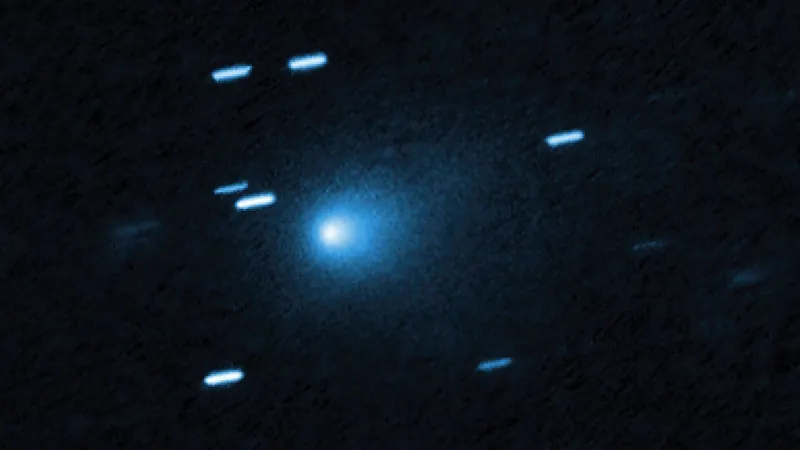
Get Ready for a Celestial Spectacle: Interstellar Comet 3I/ATLAS Zooms Past Mars Soon!
2025-09-03
Author: Wei
A Cosmic Opportunity Beckons!
Mark your calendars, space enthusiasts! The European Space Agency (ESA) is gearing up for an unprecedented chance to observe the interstellar comet 3I/ATLAS as it approaches Mars in just one month!
A Stellar Discovery
Discovered on July 1, 2025, 3I/ATLAS is the third known interstellar object to visit our solar system, with its name symbolizing this cosmic rarity. With a trajectory that leads it within an astonishing 18.6 million miles (30 million kilometers) of Mars—far closer than its 168 million miles (270 million kilometers) approach to Earth—Mars orbiters are primed to capture this celestial visitor.
ESA's Bold Plan
Colin Frank Wilson, project scientist for ESA's Mars missions, has announced that preparations are underway to observe 3I/ATLAS during its closest brush with the Red Planet, slated for October 3, 2025. On this fascinating date, the comet will be about 30 million kilometers away from Mars, making it the perfect target for celestial observations.
High-Tech Instruments at the Ready
ESA plans to utilize its Mars Express and ExoMars Trace Gas Orbiter (TGO) to gather data. Wilson revealed, "We will attempt to obtain images of the object using the High Resolution Stereo Camera (HRSC) on Mars Express and the Colour and Stereo Surface Imaging System (CaSSIS) onboard TGO." While the comet will be too distant for detailed close-ups, there's buzz that HRSC might just reveal the comet's shape—whether it's elongated like its cousin 1I/'Oumuamua or more spherical like 2I/Borisov.
Putting Science to the Test
But that’s not all! The TGO’s NOMAD and MEx's OMEGA and SPICAM spectrometers will strive to analyze the comet's spectrum, hunting for potential signs of water vapor or organic materials should the comet's activity ramp up. However, Wilson notes a cautionary tone, suggesting that they don’t expect it to be easy—"we do not have great hopes that the signal will be bright enough for spectral characterization."
A Collaborative Cosmic Effort
In addition to ESA’s missions, NASA's aging MAVEN and Mars Reconnaissance Orbiter, as well as China's Tianwen-1, could also be enlisted to catch a glimpse of 3I/ATLAS during its pass.
Beyond Mars: Opportunities for Other Spacecraft
Even spacecraft venturing beyond Mars have their eyes on the comet. ESA's Jupiter Icy Moons Explorer (JUICE), set to arrive in the Jovian system in July 2031, is also gearing up for planned observations. Joern Helbert from ESA's Solar System Section mentioned, "The JUICE spacecraft is also planning observations, albeit limited to a timeframe this November due to thermal constraints." Furthermore, other probes like Europa Clipper and Hera may traverse the comet's tail after it swings by the Sun.
The Countdown Begins!
With all these high stakes in play, the countdown has officially begun for the closest approach of 3I/ATLAS. Expect an array of data and hopefully awe-inspiring images as our planetary neighbors prepare for this interstellar flyby. Stay tuned for updates—this cosmic event promises to illuminate our understanding of the universe!



 Brasil (PT)
Brasil (PT)
 Canada (EN)
Canada (EN)
 Chile (ES)
Chile (ES)
 Česko (CS)
Česko (CS)
 대한민국 (KO)
대한민국 (KO)
 España (ES)
España (ES)
 France (FR)
France (FR)
 Hong Kong (EN)
Hong Kong (EN)
 Italia (IT)
Italia (IT)
 日本 (JA)
日本 (JA)
 Magyarország (HU)
Magyarország (HU)
 Norge (NO)
Norge (NO)
 Polska (PL)
Polska (PL)
 Schweiz (DE)
Schweiz (DE)
 Singapore (EN)
Singapore (EN)
 Sverige (SV)
Sverige (SV)
 Suomi (FI)
Suomi (FI)
 Türkiye (TR)
Türkiye (TR)
 الإمارات العربية المتحدة (AR)
الإمارات العربية المتحدة (AR)